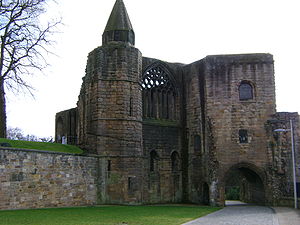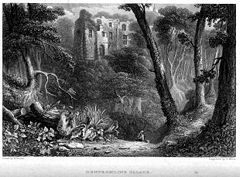
Dunfermline Palace
Encyclopedia


Scotland
Scotland is a country that is part of the United Kingdom. Occupying the northern third of the island of Great Britain, it shares a border with England to the south and is bounded by the North Sea to the east, the Atlantic Ocean to the north and west, and the North Channel and Irish Sea to the...
royal palace
Palace
A palace is a grand residence, especially a royal residence or the home of a head of state or some other high-ranking dignitary, such as a bishop or archbishop. The word itself is derived from the Latin name Palātium, for Palatine Hill, one of the seven hills in Rome. In many parts of Europe, the...
in Dunfermline, Fife
Fife
Fife is a council area and former county of Scotland. It is situated between the Firth of Tay and the Firth of Forth, with inland boundaries to Perth and Kinross and Clackmannanshire...
. It is currently a ruin under the care of Historic Scotland
Historic Scotland
Historic Scotland is an executive agency of the Scottish Government, responsible for historic monuments in Scotland.-Role:As its website states:...
and an important tourist attraction in Dunfermline
Dunfermline
Dunfermline is a town and former Royal Burgh in Fife, Scotland, on high ground from the northern shore of the Firth of Forth. According to a 2008 estimate, Dunfermline has a population of 46,430, making it the second-biggest settlement in Fife. Part of the town's name comes from the Gaelic word...
.
Dunfermline was a favourite residence of many Scottish monarchs. Documented history of royal residence there begins in the 11th century with Malcolm III
Malcolm III of Scotland
Máel Coluim mac Donnchada , was King of Scots...
who made it his capital. His seat was the nearby Malcolm's Tower
Malcolm's Tower
Malcolm's Tower is traditionally accepted as a historic site in the Scottish city of Dunfermline. The tower stood on a highly defensible peninsular outcrop of rock above a deep ravine and is the site from which the city derives its name...
, a few hundred yards to the west of the later palace. In the medieval period David II
David II of Scotland
David II was King of Scots from 7 June 1329 until his death.-Early life:...
and James I of Scotland
James I of Scotland
James I, King of Scots , was the son of Robert III and Annabella Drummond. He was probably born in late July 1394 in Dunfermline as youngest of three sons...
were both born at Dunfermline.
Dunfermline Palace is attached to the historic Dunfermline Abbey
Dunfermline Abbey
Dunfermline Abbey is as a Church of Scotland Parish Church located in Dunfermline, Fife, Scotland. In 2002 the congregation had 806 members. The minister is the Reverend Alastair Jessamine...
, occupying a site between the abbey and deep gorge to the south. It is connected to the former monastic residential quarters of the abbey via a gatehouse above a pend
Pend
Pend is a Scottish architectural term referring to a passageway that passes through a building, often from a street through to a courtyard, and typically designed for vehicular rather than exclusively pedestrian access....
(or yett), one of Dunfermline's medieval gates. The building therefore occupies what was originally the guest house of the abbey. However, its remains largely reflect the form in which the building was developed by James IV
James IV of Scotland
James IV was King of Scots from 11 June 1488 to his death. He is generally regarded as the most successful of the Stewart monarchs of Scotland, but his reign ended with the disastrous defeat at the Battle of Flodden Field, where he became the last monarch from not only Scotland, but also from all...
in a refabrication around 1500. Throughout the sixteenth century, Scotland's monarchs and royal family members were frequently in residence.
In 1589 the palace was given as a wedding present by the king, James VI, to Anne of Denmark
Anne of Denmark
Anne of Denmark was queen consort of Scotland, England, and Ireland as the wife of King James VI and I.The second daughter of King Frederick II of Denmark, Anne married James in 1589 at the age of fourteen and bore him three children who survived infancy, including the future Charles I...
after their marriage. She gave birth to three of their children there; Elizabeth
Elizabeth of Bohemia
Elizabeth of Bohemia was the eldest daughter of King James VI and I, King of Scotland, England, Ireland, and Anne of Denmark. As the wife of Frederick V, Elector Palatine, she was Electress Palatine and briefly Queen of Bohemia...
(1596), Charles
Charles I of England
Charles I was King of England, King of Scotland, and King of Ireland from 27 March 1625 until his execution in 1649. Charles engaged in a struggle for power with the Parliament of England, attempting to obtain royal revenue whilst Parliament sought to curb his Royal prerogative which Charles...
(1600) and Robert
Robert Stuart, Duke of Kintyre
Robert Bruce Stuart, Duke of Kintyre and Lorne was the fifth child of James VI of Scots and Anne of Denmark. On 2 May 1602 he was created 1st Duke of Kintyre and Lorne, 1st Marquess of Wigton, 1st Earl of Carrick, and 1st Baron of Annandale, all in the Peerage of Scotland...
(1602).
After the Union of Crowns in 1603, the removal of the Scottish court to London
London
London is the capital city of :England and the :United Kingdom, the largest metropolitan area in the United Kingdom, and the largest urban zone in the European Union by most measures. Located on the River Thames, London has been a major settlement for two millennia, its history going back to its...
meant that the building came to be rarely visited by a monarch. Ten tapestries from the royal tapestry collection
Scottish Royal tapestry collection
The Scottish royal tapestry collection was a group of tapestry hangings assembled to decorate the palaces of sixteenth century kings and queens of Scotland....
were still there in 1616, left from the time the infant Prince Charles resided at the Palace. When Charles I returned in 1633 for his Scottish coronation
Coronation
A coronation is a ceremony marking the formal investiture of a monarch and/or their consort with regal power, usually involving the placement of a crown upon their head and the presentation of other items of regalia...
he only made a brief visit to his place of birth. The last monarch to occupy the palace was Charles II
Charles II of England
Charles II was monarch of the three kingdoms of England, Scotland, and Ireland.Charles II's father, King Charles I, was executed at Whitehall on 30 January 1649, at the climax of the English Civil War...
who stayed at Dunfermline in 1650 just before the Battle of Pitreavie. Soon afterwards, during the Cromwellian occupation of Scotland, the building was abandoned and by 1708 it had been unroofed.
All that remains of the palace today is the kitchen, its cellars, and the impressive south wall with a commanding prospect over the Firth of Forth
Firth of Forth
The Firth of Forth is the estuary or firth of Scotland's River Forth, where it flows into the North Sea, between Fife to the north, and West Lothian, the City of Edinburgh and East Lothian to the south...
to the south.
External links
- Dumferline Palace and Abbey - official site at Historic ScotlandHistoric ScotlandHistoric Scotland is an executive agency of the Scottish Government, responsible for historic monuments in Scotland.-Role:As its website states:...

